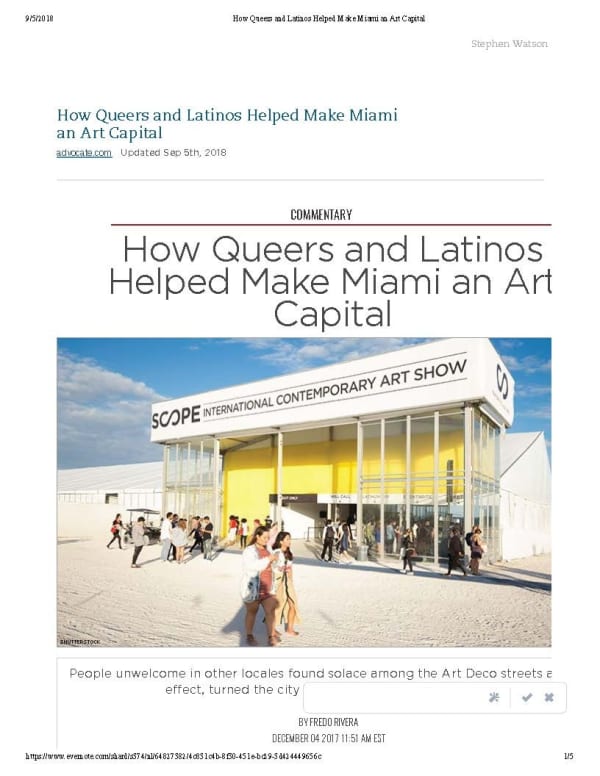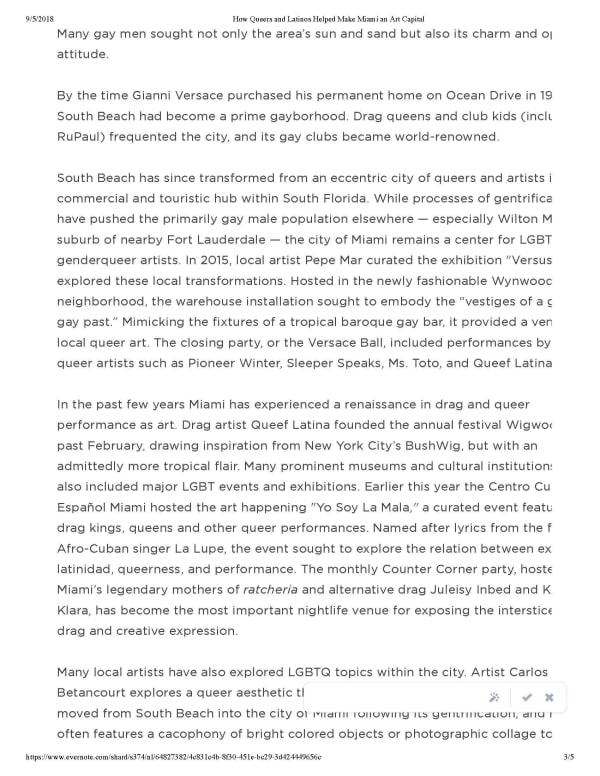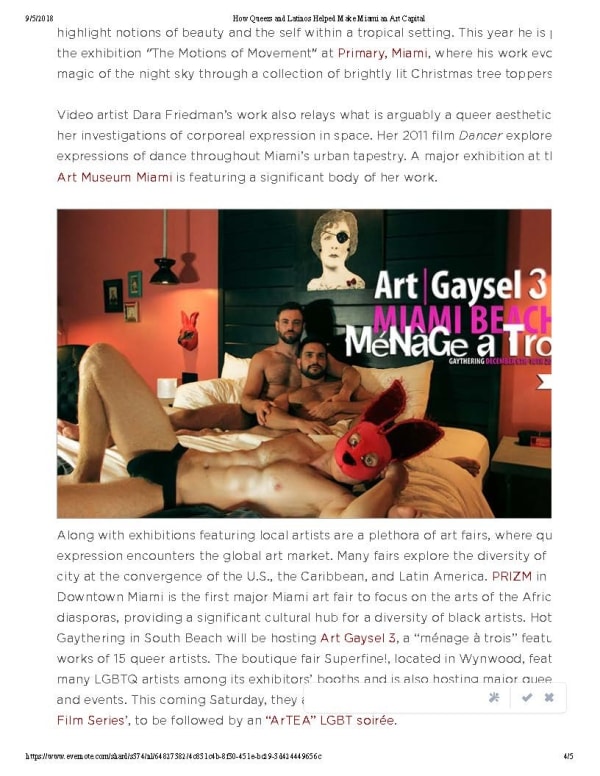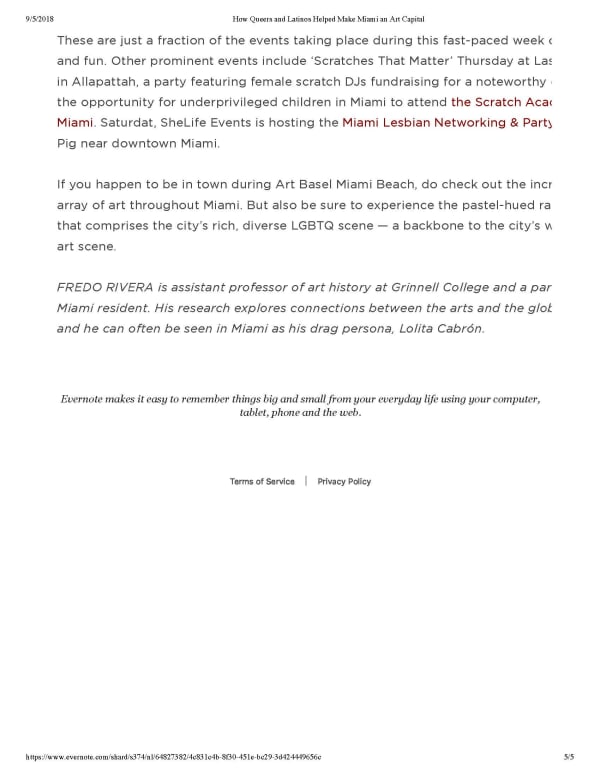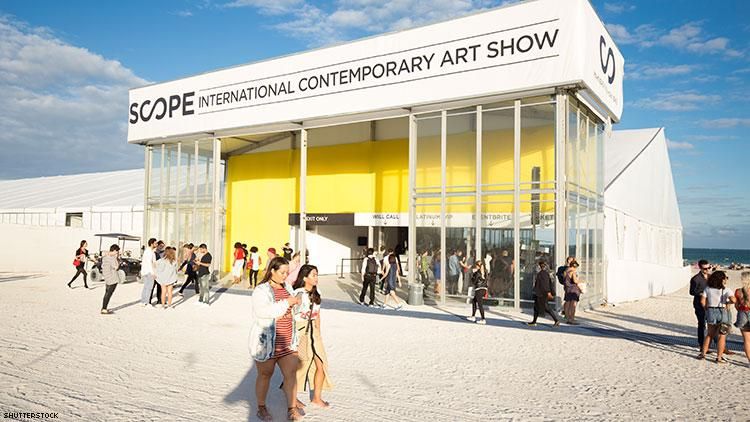Every year the bacchanalia of the art world descends upon South Florida for Art Basel Miami Beach. Taking place amid the pastel pastiche of South Beach's historic Art Deco architecture, the fair has spread its tentacles into adjacent neighborhoods - Downtown, Wynwood, and most recently Little Haiti and Allapattah.
In many ways, the art scene in Miami has developed parallel to greater Miami's LGBT nightlife - something best experienced outside the white walls of the Miami Beach Convention Center and the many tented art fairs. Drag queens still strut on the sidewalk at the newly located Palace Bar on Ocean Drive in South Beach, while specific events and exhibition venues provide a focus on the unique LGBT scene and experience within the city.
Starting with more humble beginnings in 2002, Art Basel Miami Beach proper has since expanded into a compendium of art fairs, with VIP parties and nightclubs re-creating an atmosphere akin to a contemporary The Birdcage. Art Basel has marked Miami as a global capital for the arts. Miami's transformation as a mecca of the arts cannot be disconnected from the transformations created by its LGBT residents.
The dramatic revival of South Beach in the 1980s, for example, can be credited largely to preservationist, artist. and designer Leonard Horowitz. He joined forces with the Barbara Baer Capitman. and they founded the Miami Beach Design Preservation League in 1976. Concerned about the state of dilapidation within the neighborhood, Horowitz began to paint various edifices ina rainbow of pastel colors. His efforts not only brought vivid attention to the run-down Art Deco gems within South Beach, they helped mark it as an arts, fashion, and LGBT center during the 1980s and 1990s.
The opportunity to revitalize the area was not lost on developers, particularly the intrepid Tony Goldman. Cheap rents brought in a plethora of artists, while Goldman worked to preserve both the interiors and exteriors of the local architecture. By the early 1990s, South Beach became an ideal safe haven for many coping with the AIDS crisis. Many gay men sought not only the area's sun and sand but also its charm and open attitude.
By the time Gianni Versace purchased his permanent home on Ocean Drive in 1992, South Beach had become a prime gayborhood. Drag queens and club kids (including RuPaul) frequented the city, and its gay clubs became world-renowned.
South Beach has since transformed from an eccentric city of queers and artists into a commercial and touristic hub within South Florida. While processes of gentrification have pushed the primarily gay male population elsewhere - especially Wilton Manors, a suburb of nearby Fort Lauderdale - the city of Miami remains a center for LGBT and genderqueer artists. In 2015, local artist Pepe Mar curated the exhibition "Versus." which explored these local transformations. Hosted in the newly fashionable Wynwood neighborhood, the warehouse installation sought to embody the "vestiges of a gloried gay past." Mimicking the fixtures of a tropical baroque gay bar, it provided a venue for local queer art. The closing party, or the Versace Ball, included performances by local queer artists such as Pioneer Winter, Sleeper Speaks, Ms. Toto, and Queef Latina.
South Beach has since transformed from an eccentric city of queers and artists into a commercial and touristic hub within South Florida. While processes of gentrification have pushed the primarily gay male population elsewhere - especially Wilton Manors, a suburb of nearby Fort Lauderdale - the city of Miami remains a center for LGBT and genderqueer artists. In 2015, local artist Pepe Mar curated the exhibition "Versus." which explored these local transformations. Hosted in the newly fashionable Wynwood neighborhood, the warehouse installation sought to embody the "vestiges of a gloried gay past." Mimicking the fixtures of a tropical baroque gay bar, it provided a venue for local queer art. The closing party, or the Versace Ball, included performances by local queer artists such as Pioneer Winter, Sleeper Speaks, Ms. Toto, and Queef Latina.
In the past few years Miami has experienced a renaissance in drag and queer performance as art. Drag artist Queef Latina founded the annual festival Wigwood this past February, drawing inspiration from New York City's BushWig, but with an admittedly more tropical flair. Many prominent museums and cultural institutions have also included major LGBT events and exhibitions. Earlier this year the Centro Cultural Español Miami hosted the art happening "Yo Soy La Mala," a curated event featuring drag kings, queens and other queer performances. Named after lyrics from the famed Afro-Cuban singer La Lupe, the event sought to explore the relation between exile, latinidad, queerness, and performance. The monthly Counter Corner party, hosted by Miami's legendary mothers of ratcheria and alternative drag Juleisy Inbed and Karla Klara, has become the most important nightlife venue for exposing the interstices of drag and creative expression.
Many local artists have also explored LGBTQ topics within the city. Artist Carlos Betancourt explores a queer aesthetic through memory and personal experience. He has moved from South Beach into the city of Miami following its gentrification, and his work often features a cacophony of bright colored objects or photographic collage to highlight notions of beauty and the self within a tropical setting. This year he is part of the exhibition "The Motions of Movement" at Primary, Miami, where his work evokes the magic of the night sky through a collection of brightly lit Christmas tree toppers.
Video artist Dara Friedman's work also relays what is arguably a queer aesthetic through her investigations of corporeal expression in space. Her 2011 film Dancer explores local expressions of dance throughout Miami's urban tapestry. A major exhibition at the Pérez Art Museum Miami is featuring a significant body of her work.
Along with exhibitions featuring local artists are a plethora of art fairs, where queer expression encounters the global art market. Many fairs explore the diversity of Miami, a city at the convergence of the U.S., the Caribbean, and Latin America. PRIZM in Downtown Miami is the first major Miami art fair to focus on the arts of the African diasporas, providing a significant cultural hub for a diversity of black artists. Hotel Gaythering in South Beach will be hosting Art Gaysel 3, a "ménage à trois" featuring the works of 15 queer artists. The boutique fair Superfine!, located in Wynwood, features many LGBTQ artists among its exhibitors' booths and is also hosting major queer parties and events. This coming Saturday, they are hosting 'OUTshine @ Superfine: A Queer Art Film Series', to be followed by an "ArTEA" LGBT soirée.
These are just a fraction of the events taking place during this fast-paced week of art and fun. Other prominent events include 'Scratches That Matter' Thursday at Las Rosas in Allapattah, a party featuring female scratch DJs fundraising for a noteworthy cause - the opportunity for underprivileged children in Miami to attend the Scratch Academy Miami. Saturdat, SheLife Events is hosting the Miami Lesbian Networking & Party at Blind Pig near downtown Miami.
If you happen to be in town during Art Basel Miami Beach, do check out the incredible array of art throughout Miami. But also be sure to experience the pastel-hued rainbow that comprises the city's rich, diverse LGBTQ scene - a backbone to the city's wondrous art scene.
These are just a fraction of the events taking place during this fast-paced week of art and fun. Other prominent events include 'Scratches That Matter' Thursday at Las Rosas in Allapattah, a party featuring female scratch DJs fundraising for a noteworthy cause - the opportunity for underprivileged children in Miami to attend the Scratch Academy Miami. Saturdat, SheLife Events is hosting the Miami Lesbian Networking & Party at Blind Pig near downtown Miami.
If you happen to be in town during Art Basel Miami Beach, do check out the incredible array of art throughout Miami. But also be sure to experience the pastel-hued rainbow that comprises the city's rich, diverse LGBTQ scene - a backbone to the city's wondrous art scene.
